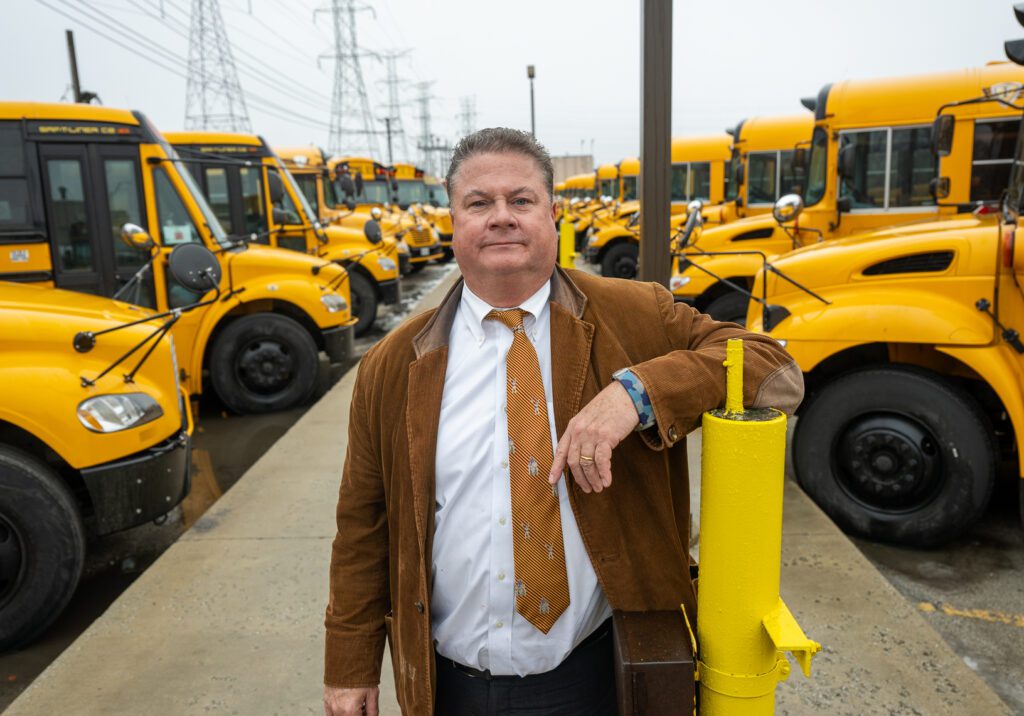Buses are invaluable. They get workers across town, kids to school, travelers from the parking lot to the terminal and much more.
Buses can also be stressful. Will you catch it? Will it reach the destination on time? Will it have enough space? Will the driver be helpful?
Most buses use diesel engines for safety, reliability, efficiency, durability and cost efficiency.1 And though the fuel for those engines can’t prevent buses from getting stuck in traffic, some alternative options can help everyone breathe easier — thanks to U.S. Soy.
Biodiesel and renewable diesel are produced from renewable feedstocks like soybean oil and used cooking oils with different processes. They both can be used in place of petroleum-based diesel without any changes to vehicle engines.2 Research has shown that biodiesel can reduce lifecycle greenhouse gases by 86% and particulate matter by 47% compared to petroleum-based diesel.3
Those advantages caught the attention of John Benish Jr., president and chief operating officer of Cook-Illinois Corporation, the sixth largest school bus contractor in the United States. A second-generation executive of the family-owned-and-operated company, he started powering his bus fleet with biodiesel blends in 2005, and he hasn’t looked back.
Clearing the Air
Benish Jr.’s father began ferrying school children in the rapidly expanding Chicago area in 1958. From then through the 1990s, Benish Jr. remembers the plume of black smoke that would rise above the iconic yellow school buses when the driver started the engine.
Today, his company operates 2,050 school buses in the Chicago, Illinois, area, in the heart of the U.S. Midwest, as well as 25 shuttle buses at Chicago Midway Airport. They all run on blends of biodiesel. The fleet includes five school buses powered by 100% biodiesel, and he plans to add more of these buses.
“I’ve come to the conclusion that biodiesel is the fastest, easiest way to decarbonize a school bus and clear the air, because it can be used immediately in existing diesel technology, rather than investing in a new fleet or waiting for future technologies,” Benish Jr. says. “I hear a lot of talk about electric, and that may happen in the future, but it’s a long way off for buses, practically speaking. We can accomplish the same goals with fuels like biodiesel, and that’s my message to other fleet managers.”
His message resonates. In the United States, New York City requires all city fleet vehicles and equipment to use biodiesel. Other cities, like Chicago, New Orleans and Washington, D.C., also use biodiesel fuel in city buses and vehicles, and the state of California has a plan to switch entirely to biodiesel by 2030. Soybean oil, crushed and extracted from soybeans, accounts for nearly 45% of the feedstocks being used to produce biodiesel in United States.4
In using biodiesel, Benish Jr. is part of a global effort to improve air quality. The European Union leads the world in biodiesel production and use, with France, Germany, Spain, Sweden and Italy accounting for about two-thirds of the market.5 Indonesia has the world’s highest transport fuel blending mandate, requiring a minimum 35% biodiesel or renewable diesel blend, while China is beginning to unlock the potential of used cooking oil as a fuel feedstock.6 Soybean oil accounts for a notable portion of cooking oil in China and many other countries.
Accessing Health Benefits
“The fuel is extremely reliable, but at the heart of our commitment to biodiesel is that it is better for the children,” Benish Jr. says. “We transport up to 150,000 students every morning and afternoon, including many special needs kids, and breathing issues and asthma are common. Biodiesel reduces harmful exposure.”
He adds that this was even more noticeable and impactful in the early 2000s, before diesel technology became dramatically cleaner.
According to a recent study on the health benefits of biodiesel, using pure biodiesel, or B100, could reduce pollution significantly. The research projected the benefits of using 100% biodiesel in legacy heavy-duty transportation, meaning vehicles without updated diesel technology, residential heating — two of the most difficult fuel uses to decarbonize — in 28 communities considered among the most polluted in the United States.7
The health benefits identified by the study include:
- Reduced cancer risk.
- Reduced asthma cases.
- Fewer premature deaths.
- Fewer sick days.
Building on U.S. Soy Success
Under Benish Jr.’s leadership, Cook-Illinois Corporation was the first company in the state of Illinois to switch an entire bus fleet to blends up to 20% biodiesel, or B20. He found biodiesel noticeably better for the engines, which show reduced wear and tear due to the fuel’s enhanced lubricity.
Success with biodiesel across his bus fleets laid the foundation for Benish Jr. to evaluate other products made with U.S. Soy, such as tires made by Goodyear Tire & Rubber Company. He even wears a pair of Skechers shoes with a tread made from the same high-performing soy-biobased technology that Goodyear uses in tires.
“I like products made from soy because they are renewable and also healthier than their petroleum counterparts,” he says.
His home state of Illinois is one of the largest in soybean production, so he his use of biodiesel and other products derived from U.S. Soy supports other family-owned businesses in his area — another reason to breathe easier.


References
1 Public Transportation, Engine Technology Forum, accessed January 2024.
2 Clean Fuels: Better. Cleaner. Now! Clean Fuels Alliance America, accessed January 2024.
3 Building the Biodiesel Industry, American Soybean Association, accessed January 2024.
4 Renewable Diesel and Biodiesel Feedstock Trends over 2011–2022, Maria Gerveni, Todd Hubbs and Scott Irwin, farmdoc daily (13):80, Department of Agricultural and Consumer Economics, University of Illinois at Urbana-Champaign, May 1, 2023.
5 About biodiesel, European Biodiesel Board, accessed January 2024.
6 Biofuels Pivot to Asia, OpenMarkets, CME Group, May 5, 2023.
7 Clean Fuels Health Benefits Study, Clean Fuels Alliance America, accessed January 2024.
